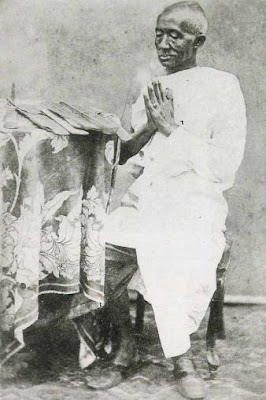Elizabeth Mackintosh, aka Gordon Daviot, aka Josephine Tey. |
Few people have heard of Elizabeth Mackintosh, even those familiar with her work. She’s a mystery; she’s a writer of mysteries; she’s a mystery writer read by people who don’t like mysteries. Significantly, she solved a five-hundred-year-old mystery. Playwright and author, she died in 1952 at the age of fifty-five. Born and raised in Iverness, Scotland, Mackintosh was trained as a physical training instructress, and taught for eight years at various schools in Scotland and England. When her mother died she quit to stay and take care of her invalid father. She started to write while tending him and sold some stories. She also began to seriously study playwriting and theater.

Her most successful play was Richard of Bordeaux, which she wrote using the pen name Gordon Daviot. It was first performed in 1932, and was so successful that it established her name as a dramatist, and made a name for the young leading actor and director, John Gielgud.
Her interests informed her writing. An amateur psychologist, she studied people and tried to ferret out their personal mysteries – who they really were and what they kept hidden from the world. She prided herself on reading faces and facial expressions and even studied their penmanship. All of these skills she aptly applied to her most famous mystery, Daughter of Time, which she wrote under the nom de plume Josephine Tey.
Richard III Artist unknown, Late 15th Century National Portrait Gallery, London. |
The protagonist of five of her mysteries (and a minor character in another) is Inspector Alan Grant of Scotland Yard. In Daughter of Time, Inspector Grant is laid up in a hospital. Like Tey herself, Grant studies faces. Given a portrait of Richard III, he finds him to be quite honorable, but ill at ease. He is horrified to find out the man’s villainous reputation - Richard is accused of killing his nephews, princes Edward V and Richard of Shrewbury, and Grant sets out to prove that his initial instincts concerning Richard III are correct. From his hospital bed, with the help of friends and a young researcher, he comes to the conclusion that Richard was not the heinous murderer he was thought to be, and offers another answer as to who really killed the princes in the Tower of London.
Earliest known portrait of Richard III, 1520s, Society of Antiquaries. |
Without revealing the entire book, some of the salient facts presented by Tey are compelling. For one thing, Richard was never formally accused of either kidnapping nor murdering his nephews. One would think this would be an issue, since at that time his reign was being challenged. Secondly, their mother, Elizabeth Woodville, remained on good terms with Richard, which makes her the bigger monster if she had thought him guilty of the murders of her sons. Finally, there wasn’t any political advantage to get rid of them. They were more in the way of Henry Tudor (Henry II).
Frontispage of 1st Quarto Shakespeare's Richard III. |
That history is written by the victors has never been more true than in the case of Richard III. Sir Thomas More was the author of the unfinished History of King Richard the Third (1513), and he served Henry VIII, son of Henry Tudor who vanquished Richard. It is an understatement to say that More toed the party line. Also, More was eight years old when Richard died, so what he wrote was hearsay with a Tudor bent. Shakespeare has been known to tweak historical facts for the sake of his art, and unfortunately his play, Richard III, has been taken all these centuries to be a history rather than a tragedy. However, his play may be the reason that Richard III has remained in popular memory, whereas other British monarchs have been virtually forgotten. One also has to consider that at the time of these writings history was not even a genre of its own, but rather was considered a subset of literature. Therefore historical accuracy was not necessarily a focus or consideration.
Sir Thomas More, 1527, by Hans Holbein the Younger National Portrait Gallery, London. |
A recurring theme in Tey’s work is injustice, and in Daughter of Time she successfully demonstrates that once an idea becomes a part of culture it is hard to correct even with contrary evidence. Her keen detection, centuries after the fact, has been so impressive that the various Richard III societies that have sprung up internationally supporting his acquittal of this crime have made her their poster child. This book was called by American crime writer and literary critic Dorothy B. Hughes “not only one of the most important mysteries of the year, but of all years of mystery.”
True First Edition. London: Peter Davies, 1951. |
And Elizabeth Mackintosh remained a mystery until the day she died. John Gielgud wrote, "Her sudden death...was a great surprise and shock to all her friends in London. I learned afterward that she had known herself to be mortally ill for nearly a year, and had resolutely avoided seeing anyone she knew. This gallant behaviour was typical of her and curiously touching, if a little inhuman, too.”
If you are interested in the mystery of history, then Daughter of Time is the mystery for you. Think CSI without the gadgets; only a sharp mind as a tool. A bit inhuman, perhaps, but remaining aloof from humanity while investigating it is the fictional detective’s stock in trade. Recall Sherlock Holmes and Hercule Poirot. And then remember that Josephine Tey, née Elizabeth Mackintosh, the mysterious mystery writer, was not a detective in a novel. She was the real deal.
***************
Unless otherwise noted, images courtesy of Wikipedia.
Unless otherwise noted, images courtesy of Wikipedia.
An earlier version of this post appeared on Booktryst.
******************************































